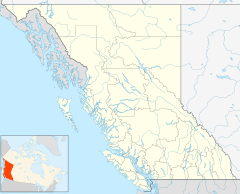Read Island, British Columbia facts for kids
Quick facts for kids
Read Island
|
|
|---|---|
| Country | |
| Province | BC/BCE |
| Area code(s) | 250, 778 |
Read Island is a small, quiet area located on the east side of Read Island in British Columbia, Canada. It is found near the southern tip of the island. This place is part of the beautiful Discovery Islands region, which is off the coast of British Columbia.
Read Island is known as an "unincorporated locality." This means it doesn't have its own city government or mayor. Instead, it's managed by a larger regional district. It's also a "census-designated place," which means it's an area that Statistics Canada defines for counting people during the national census. This helps them gather important information about where people live.
Contents
Where is Read Island Located?
Read Island is part of the Discovery Islands, a group of islands and islets between Vancouver Island and the mainland of British Columbia. This area is famous for its stunning natural beauty and calm waters. The island is situated in the South Coast of British Columbia, a region known for its many islands, inlets, and forests.
Exploring the Discovery Islands
The Discovery Islands are a popular spot for outdoor activities. Many people visit for boating, kayaking, and wildlife watching. The waters around the islands are home to various marine animals. These islands are a true paradise for nature lovers.
How to Get to Read Island
Getting to Read Island usually involves a boat or a floatplane. There are no bridges connecting it to the mainland or other larger islands. This makes it a peaceful and somewhat remote place. It's a great spot for those looking to escape busy city life.
Life on Read Island
Life on Read Island is often quiet and connected to nature. The community is small, and residents enjoy the peaceful environment. Many people who live here appreciate the chance to be close to the ocean and the forests.
What is an Unincorporated Locality?
An unincorporated locality, like Read Island, is a place where people live but it's not officially a town or city. It doesn't have its own local government. Instead, services like roads or emergency response are often provided by the larger regional government. This is common in many rural areas.
Why are Places Designated for Census?
A census-designated place helps the government count how many people live in specific areas. Even if a place doesn't have a city hall, knowing its population is important. This data helps with planning for schools, hospitals, and other services. It ensures that even small communities are counted and considered.
Nature and Wildlife Around Read Island
The area around Read Island is rich in wildlife. The forests are home to various birds and land animals. The surrounding waters are full of marine life. It's a fantastic place for observing nature.
Marine Animals in the Discovery Islands
The waters around Read Island are part of a vibrant marine ecosystem. You might spot seals, sea lions, and even orcas or whales passing through. These waters are also home to many types of fish.
Forest Life and Birds
On the island itself, you can find lush forests. These forests provide a habitat for many animals. Birdwatchers might enjoy seeing different species of birds. The natural environment is a key part of Read Island's charm.
History of Read Island
The history of Read Island is tied to the broader history of the British Columbia Coast. Indigenous peoples have lived in this region for thousands of years. Later, European explorers and settlers arrived, often involved in logging or fishing.
Early Settlers and Industries
In the past, industries like logging and fishing were important to the economy of many coastal communities, including those around Read Island. These activities shaped how people lived and worked on the island.
How the Island Got Its Name
Many places in British Columbia were named after explorers, naval officers, or important figures. While the exact origin of Read Island's name might require more research, it likely follows a similar pattern. Place names often tell a story about the region's past.


